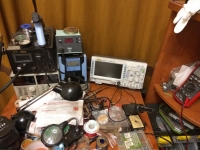rsv6 wrote: tplewa wrote: @ rsv6
What can I say. If you say that analogs are crap, buy a cheap digit, you will see how such equipment works ... ... but unfortunately the truth is that a digit on which you can work without problems requires quite a lot of money. Therefore, in the absence of cash, an analog is a good option, and in some applications it is even better than cheap numbers (one of the more sensible options is Rigiol, which we wrote about in the thread).
BTW, the lamp from lying down is unlikely to die ... the reason had to be different ....
Here is the problem with the failure of these lamps, so I got serious about it and it is impossible to fix it ...
The lamp can be replaced and it is usually not that expensive.
You just need to model the lamp and look for it. Oscilloscopes described as "unproven but the lamp shines" can be used as donors.
Usually, in the case of analog oscilloscopes, it is also possible to find a schematic. As long as I'm looking for it, OS360 is not there.
However, for the more popular models, such as the C1-112, there is no problem with the diagram.
I also found for my niche C1-107. The manual itself contains a block diagram + a list of elements (a list according to numbers on the PCB). On the internet I have an analog circuit diagram for an oscilloscope. Only the multimeter diagram is missing (I have a damaged one, it is a separate block so it does not affect the operation of the oscilloscope part).
If a colleague wonders why these dumbbells are not suitable, let him see what sampling rates have, for example, the Rigol DS1052E oscilloscope. 2 Channels at 50MHz have a sampling rate of 500MSa / s, this dumbbell is 48MSa / s.
Something I don't think it works well for at over 10 times the sampling rate.
From what I read in the past, algorithms are used which, with such a limited number of samples, try to generate an approximation of the course.
A colleague of a functional C1-112 will hunt or something like that and it will be fine.
You can get diagrams, spare parts and a lot of operating descriptions for these models. The Soviet Union often cloned integrated circuits alive, so matching anything among modern components is not a problem.



